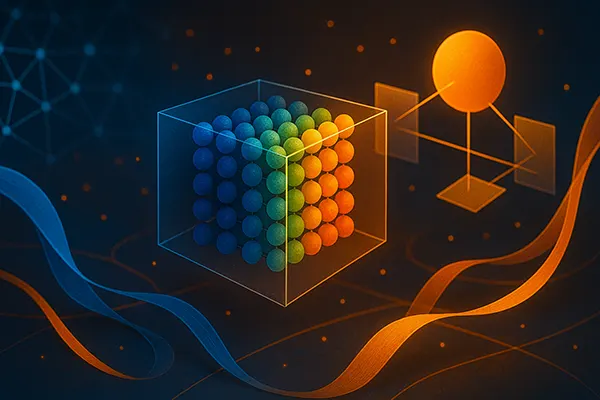Tensor Networks in Modern Machine Learning: Concepts and Practical Applications Beyond Classical Neural Models

Tensor networks have become an active research direction in machine learning, offering a structured approach to handling high-dimensional data with reduced computational cost. Their mathematical roots come from quantum many-body physics, yet by 2025 they have gained a stable position in research on efficient models, explainability and compression. This article provides a detailed look at how tensor networks work and how they are used across machine learning tasks that extend far beyond classical neural architectures.
Fundamental Principles of Tensor Networks
Tensor networks represent complex multi-dimensional arrays as interconnected smaller tensors. This factorisation allows researchers to manage exponential growth in dimensionality, keeping computations tractable without manually reducing the size of input data. Their structure encodes dependencies between variables in a compact manner, improving both performance and interpretability.
A core advantage of tensor networks is the ability to impose physical or statistical constraints directly into the model. For example, Matrix Product States (MPS) restrict correlations to a manageable range, which is beneficial for sequential data and time-series analysis. These models avoid unnecessary parameters and help maintain stability even when handling long sequences.
By 2025 tensor-based approaches are widely explored as alternatives to deep neural networks in resource-limited settings. They enable substantial parameter compression while maintaining competitive accuracy across image processing, natural language tasks and scientific modelling. This efficiency has turned tensor networks into an attractive tool for researchers seeking reliable structures that scale with large datasets.
Key Tensor Network Architectures Used in Machine Learning
Matrix Product States (MPS) remain the most commonly applied architecture because of their flexibility and low computational overhead. They are particularly useful for sequence-to-sequence modelling, audio signal analysis and lightweight language models that run on edge devices. Their linear topology simplifies training and makes them suitable for real-time applications.
Tree Tensor Networks (TTN) offer a hierarchical structure that resembles decision trees or hierarchical clustering. They have been used in image classification and structured data processing where feature interactions need to be captured across multiple scales. TTNs reduce redundancy by ensuring that each contraction step reflects a meaningful transformation.
More complex structures, such as Projected Entangled Pair States (PEPS) or Multi-scale Entanglement Renormalisation Ansatz (MERA), appear in tasks requiring highly expressive representations. These architectures are computationally heavier but support modelling of intricate correlations. Researchers use them in physics-informed learning, advanced simulations and specialised scientific applications.
Tensor Networks for Data Compression and Model Reduction
Efficient compression is one of the strongest advantages of tensor networks. They allow large neural models to be transformed into compact representations without major performance drops. This approach reduces memory consumption and energy costs, which is valuable for mobile devices and embedded systems where traditional deep architectures remain impractical.
Tensor Train decomposition is frequently employed to compress fully-connected layers in neural models. Instead of storing millions of parameters, the decomposition keeps only several small cores, significantly reducing storage needs. This technique has contributed to new lightweight training strategies during 2024–2025, especially in applied robotics and remote sensing.
Compression via tensor networks is also used for improving model interpretability. Factorised cores allow researchers to inspect the contribution of specific variables more easily, supporting safer deployments in finance, engineering and healthcare. This structured transparency provides clarity that classical models with dense matrices often lack.
Practical Use Cases Across Industries
In telecommunications tensor networks support efficient modelling of signal correlations in multi-antenna systems. By managing high-dimensional data interactions, they improve detection accuracy and reduce the computational load in real-time communication systems operating under strict latency limits.
In the energy sector tensor-based surrogate models increasingly assist in optimising smart-grid operations. Their structure helps approximate complex physical processes while retaining reliable prediction quality, an essential requirement for large-scale system control and planning. This direction is actively developed in Europe and East Asia.
Manufacturing industries use tensor networks for defect detection and pattern recognition on production lines. Their compactness allows deployment on local hardware, eliminating the need for cloud-based inference. This reduces decision delays and supports industrial safety standards. By 2025 such models have already been adopted in automated inspection systems.

Extending Tensor Networks Beyond Classical Deep Learning
Tensor networks introduce alternative learning paradigms that do not rely on densely connected neural architectures. They provide a mathematically principled method for capturing structure in datasets where high dimensionality or sparse correlations present challenges for standard models. Their applicability continues to expand as computational tools mature.
One promising avenue is hybrid machine-learning-physics modelling. Tensor networks integrate naturally with differential equations, allowing researchers to combine theoretical constraints with empirical data. This has gained popularity in climate modelling, molecular simulations and materials science, where purely data-driven models may lack reliability.
Another active direction is the use of tensor networks in privacy-preserving computation. Because tensor factorisation distributes information across multiple small cores, these structures offer potential advantages for secure model sharing and federated learning. Research groups in 2025 are exploring how tensor-core interactions can enhance both security and decentralised training.
Future Directions and Research Challenges
A key challenge lies in developing efficient algorithms for contracting large tensor networks. Although many techniques exist, scalability remains a limiting factor for deployment in commercial systems. Ongoing work focuses on optimising contraction paths and leveraging specialised hardware accelerators.
Integrating tensor networks with transformer-style models is another complex research topic. Early studies show that factorised representations can reduce the quadratic attention cost, but designing stable training procedures is still difficult. Success in this area could lead to more resource-efficient language and vision models.
As interest grows, standardisation of libraries and frameworks will be crucial. By 2025 multiple research groups contribute to open-source implementations, but interoperability issues persist. Unified tooling will help practitioners adopt tensor networks more widely and accelerate scientific progress.





